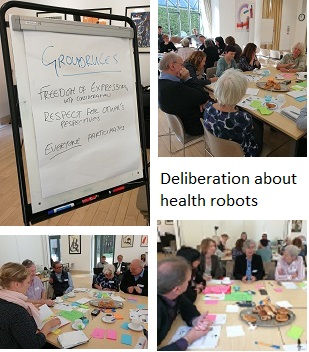Mini-Public I
Mini-Public I
REELER invited members of the public, policy-makers and academics to discuss ethics in relation to healthcare robots at our first Mini-Public in Cambridge, Oct. 2017 at the Gonville and Caius College, the Stephen Hawking building.
A mini-public is a democratic innovation that may improve opportunities for citizens to contribute to parliamentary deliberation on a given topic. The topic of the first REELER Mini-Public was robots in health care. Health care robots have the potential to radically change how healthcare provision is given, and how patients are treated.

The overall aim of the REELER Mini-Publics
REELER’s use of the mini-public methodology is inspired by two deliberative processes defined as educative form and participatory advisory panel (Archon Fung, 2007).
The former is about using the mini-public as a forum to increase public knowledge about the ethics of robots, and the latter to transfer the concerns and issues of the public in their deliberations into deliverables, reports and papers by REELER to the European Commission, academic community and political representatives.
Not enough knowledge about human-robot interaction
Though the attendees at our mini-public all had an interest in the topic, robots in health care, they also expressed lack of knowledge/information about the use and characteristics of robots in health care, and a number of questions arose:
When is the technology a robot and when is it a machine?
What types of tasks do robots solve in the health care sector today?
Who decides whether or not to introduce robot technology in a care situation?
The opportunity to receive research-based, unbiased information about the topic from different perspectives such as economic effects, technological possibilities and social impact was very welcomed.
Expert presentations and Information Sharing
To support our participants’ deliberation on the issues, we invited speakers to give non-biased, factual talks on three aspects of healthcare robotics.
- Professor Cathrine Hasse, Aarhus University, presented research on definitions and perceptions of what a robot is and empirical observations of how robots can impact the social lives of people offering and receiving healthcare.
- Professor Andreas Pyka, Hohenheim University, explained how innovation processes - such as the introduction of robot technology in society - may have positive and negative societal consequences and introduced some possible quantitative and qualitative effects of healthcare robots.
- Director Maria Bulgheroni, Ab.Acus srl, showed the attendees a range of robot technology solutions currently in use in the healthcare sector.
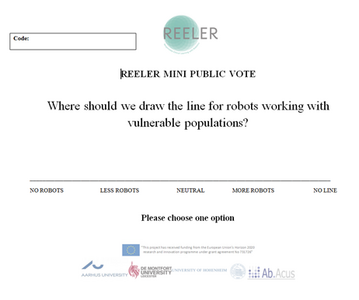
Giving voice through voting
The mini-public schedule is a methodological process with attention paid to the process of voting, deliberation and judgement. We asked participants to vote around the question:
Where should we draw the line for robots working with vulnerable populations?
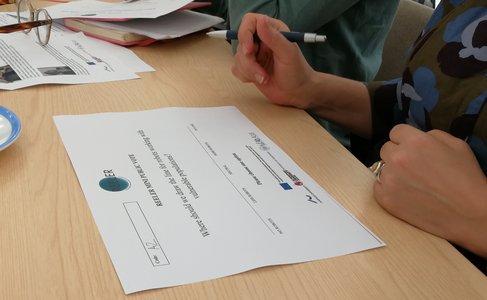
Anonymous votes
Each attendee was assigned a code which was referenced in each vote to observe if views had shifted over the course of the day. We asked the participants to vote three times during the course of the day; before any factual information was given, after expert talks and lastly after 2x deliberation time.
Participants were invited to rate their answer along a Likert scale from No Robots - Less Robots - Neutral - More Robots - No Limit.
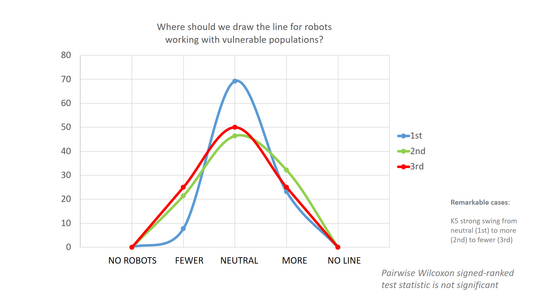
Results of the vote
At the end of the day we were able to present the results of the mini-public votes back to the participants. Most participants had not shifted in their choices throughout the day.
Results from vote 1 and vote 2 shows the spread of voting with less participants holding neutral positions after having received factual information, but we see little shift in opinion from vote 2 and vote 3.
A qualitative scrutiny of the results revealed that most participants favoured robots in healthcare to do the monotonous or heavy work, while leaving personal contact and care to people.
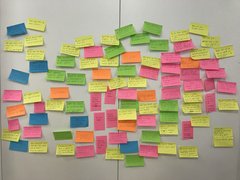
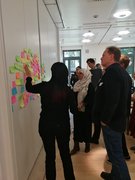
Themes elicited from the mini-public deliberations
A range of interesting view points and concerns emerged as the participants deliberated about the statements put forth in the expert talks. Participants were encouraged to write down questions and considerations through the presentation and deliberation processes as input for the discussions and REELER's further research work. Three main points emerged:
Little knowledge of what a robot and human-robot interaction is
Almost all of the mini-public participants expressed a lack of knowledge about the use and characteristics of robots in healthcare; what type of tasks do they solve? What type of robots are currently in healthcare? To what extent are they being used? And what is a robot?
- “Well, we’ve learnt a quite wide definition of robot today that seems to be as much a camera that looks at your gut under somebody’s control as—”
- “I think that’s one of the problems, yeah. You said about defining, sorry, you said about defining robots, very important.”
- “Shall I just put one down? I mean I don’t understand the question but shall I put one down? … But we don’t know how much interaction there is anyway.”
Type of robot matters
The type of robot and type of service the robot is expected to provide greatly affected the participants' attitude to Human-Robot Interaction in healthcare. Much concern and skepticism was expressed toward the use of social robots in the (health) care of vulnerable people, whereas other types of robots, such as surgical robots and rehabilitation robots, were much more welcomed and were regarded ethically less challenging/provocative.
- “So it was the use of healthcare robots with vulnerable people. … I think if you differentiate between social robots and other robots then the risks are different. They’re not necessarily any greater or worse, greater or less. But the risks you’re thinking about are different. So although technically I circled the same thing at the beginning of the morning and just then, the reasons why are different.”
- “So I started off voting quite positively. And then – but not really for any reason, but just like a general mood, a positive attitude towards it. I’ve moved to neutral for the last couple because I think with the sort of practical medical tooly robots, it seems ultimately beneficial. But I’m much more wary of the social side of it. And in particular people who might not know that they’re interacting with a robot, be aware of that. And something to do with the interdependence of different people on each other, just made me feel like I should be a bit more wary about some things.”
Bringing policy-makers/decision-makers and citizens together
Participants aired concern if citizens’ only way of expressing their opinion towards robots might be through consumerism; i.e. either buy or refrain from buying robot technology. Thus, the participation of the Programme Officer of the European Commission - DG Connect – robotics was highly appreciated. Likewise, hearing the thoughts and concerns of ordinary people, who might not be custom to working with and thinking about robots, proved to be useful for decision-making activities in this area:
- “… it was really interesting for me to hear your views as citizens and as practitioners. And I came and I had to vote the first time in the morning and I said more robots because I’m terribly excited, that’s the reason why I’m doing the job I’m doing. And I went to neutral. Because listening to all your questioning, all your concerns, all your fears, I kind of felt less confident that we knew exactly where we are going. … I can guarantee you as a – presenting a kind of public administration, that we are not going – our plan is certainly not to impose anything on anyone. It’s really to develop something which is of use for citizens. That’s what I wanted to make clear, and that’s why I will go back home with those questions.”
